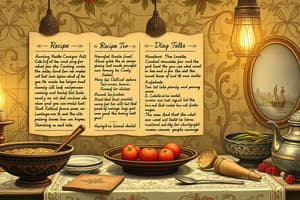Podcast
Questions and Answers
In a standard recipe, ingredients are listed in order of use.
In a standard recipe, ingredients are listed in order of use.
True (A)
The word 'Great' in cookery terms means to stir vigorously with a wooden spoon.
The word 'Great' in cookery terms means to stir vigorously with a wooden spoon.
False (B)
When a recipe calls for 'folding in' ingredients, it means vigorously stirring them with a whisk.
When a recipe calls for 'folding in' ingredients, it means vigorously stirring them with a whisk.
False (B)
To 'grease' a pan in cooking means to remove excess water from food.
To 'grease' a pan in cooking means to remove excess water from food.
When a recipe mentions 'yield', it refers to the number of servings made.
When a recipe mentions 'yield', it refers to the number of servings made.
In a recipe, to 'melt' an ingredient means to shred it into small pieces.
In a recipe, to 'melt' an ingredient means to shred it into small pieces.
The term 'decorating' in cooking means to flatten dough using a rolling pin.
The term 'decorating' in cooking means to flatten dough using a rolling pin.
In a recipe, 'sifting' means passing dry ingredients through a sieve to remove lumps and aerate mixtures.
In a recipe, 'sifting' means passing dry ingredients through a sieve to remove lumps and aerate mixtures.
To prevent food from sticking, you should ______ the pan
To prevent food from sticking, you should ______ the pan
When you ______ an ingredient, you turn solids into liquids by applying heat
When you ______ an ingredient, you turn solids into liquids by applying heat
To remove the outer skin from fruits or veggies, you should ______
To remove the outer skin from fruits or veggies, you should ______
When you ______ ingredients, you add or cut pieces of fat into flour, making it into small pieces
When you ______ ingredients, you add or cut pieces of fat into flour, making it into small pieces
To attractively finish off a sweet dish, you should ______ it
To attractively finish off a sweet dish, you should ______ it
When you ______ ingredients, you lightly mix them in using a spatula
When you ______ ingredients, you lightly mix them in using a spatula
To beat ingredients vigorously with a whisk, you should ______
To beat ingredients vigorously with a whisk, you should ______
To remove excess water from food, you should ______ it
To remove excess water from food, you should ______ it
Flashcards are hidden until you start studying
Study Notes
Cooking Terminology
- Ingredients in a recipe are listed in order of use for clarity and ease of preparation.
- The term 'Great' refers to vigorous stirring using a wooden spoon.
- 'Folding in' involves gently incorporating ingredients, not vigorously stirring as with whisking.
- 'Grease' a pan means to coat it with fat to prevent sticking, not to remove excess moisture from food.
- 'Yield' indicates the total number of servings a recipe produces.
- 'Melt' involves changing a solid ingredient to a liquid through heat, but not shredding it into small pieces.
- 'Sifting' refers to passing dry ingredients through a sieve to eliminate lumps and aerate the mixture.
Cooking Actions
- To prevent food from sticking, grease the pan.
- To melt an ingredient, apply heat that turns solids into liquids.
- To peel, remove the outer skin of fruits or vegetables.
- 'Cutting in' refers to combining fat with flour to create small, crumbly pieces.
- To decorate a sweet dish, finish it attractively, often with icing or toppings.
- 'Folding' involves lightly mixing ingredients using a spatula.
- To beat ingredients, use a whisk vigorously for thorough mixing.
- To remove excess water from food, drain it.
Studying That Suits You
Use AI to generate personalized quizzes and flashcards to suit your learning preferences.




